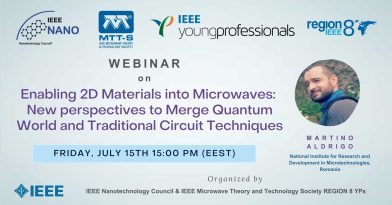
-
Friday, July 15, 2022 3:00 pm - 4:00 pm(Cairo Time) Add to my calendar
Enabling 2D Materials into Microwaves: new perspectives to merge quantum world and traditional circuit techniques
Dr. Martino Aldrigo
National Institute for Research and Development in Microtechnologies, Romania
Abstract: New communications and radar systems (such as 5G, 6G, and beyond) require small and tunable high-frequency devices, since their backbone is the Internet-of-Things (IoT) that is a wireless network interconnecting tiny objects such as sensors, actuators, and detectors. The need for ultrafast, low-energy-consumption information processing of an exponentially increasing data volume will lead to a global mobile traffic reaching 4394 EB by 2030, thus starting the 6G era of an “ubiquitous virtual existence” when all life activities will be interconnected in real time, not only “things” as in 5G era. In this respect, nanotechnologies have been attracting a lot of attention in the very last years, thanks to their enormous potentialities in creating new paradigms for future electronics. Going hand in hand with materials science, the goal is to create macroscale devices and components for practical microwave applications. A multidisciplinary approach is mandatory in such cases, as well as a strong collaboration among scientists with different backgrounds. Two-dimensional (2D) materials (like graphene, dichalcogenides, and a new class of nanoscale ferroelectrics) have been gaining momentum thanks to the exploitation of advanced nanolithography techniques, which can provide nanometer-size resolution for a variety of devices (e.g., planar/geometrical diodes and field-effect transistors, among others). In all these cases, one must consider starting from atomistic/multi-physics simulations and modelling to predict in the most accurate way the performance of 2D-material based devices, as classic electromagnetic and circuit methods are not sufficient to describe the complexity of the physical phenomena leading to the desired behavior. As a consequence, it is now possible to integrate 2D materials into microwave systems at different levels, e.g., antennas, diodes, FETs, switches etc. Also, targeting CMOS compatibility is of utmost importance to obtaining technological solutions that are suitable for large-scale fabrication. In this webinar, a bridge will be proposed between the quantum world and traditional circuit techniques, by presenting some examples of 2D material-based systems, which encompass design, simulations, modelling, fabrication, and experimental characterization.
Speaker’s Bio: Martino Aldrigo received the Ph.D. degree in electronic engineering, telecommunications, and information technology from the Faculty of Engineering, University of Bologna, Bologna, Italy, in 2014. Since January 2022, he has been a Principal Researcher II with IMT-Bucharest, Voluntari, Romania.,He has coauthored more than 70 papers in ISI ranked journals and conferences. His main research interests include electromagnetic simulation and experimental characterization of RF/microwave/ millimeter-wave/THz systems for wireless/energy-harvesting applications embedding carbon-based, 2D, and nanoscale ferroelectric materials. He is/ was a reviewer for many journals and the Co-Chair in international conferences.
This webinar is organized by IEEE Nanotechnology Council & IEEE Microwave Theory and Technology Society REGION 8 YPs.